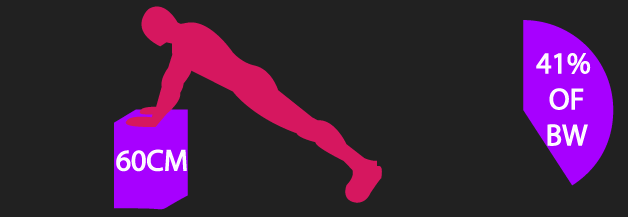
The push-up is a simple and convenient exercise that undoubtedly has the potential to induce meaningful strength, endurance, and muscle gain.
In fact, in another article, we discuss how the current research demonstrates that the push-up has the potential to produce similar muscle and strength gain to the barbell bench press.
In this short article, we’ll explore how much weight you press during a push-up.
Push-up Weight Percentages
This study by Ebben et al. gives us the answer. With a regular push-up, you are pressing roughly 64% of your bodyweight.
Kneeling push-ups (where your knees are touching the ground) have you press around 49% of your bodyweight.
Push-ups with your feet 30cm elevated (decline push-up) have you press roughly 70% of your bodyweight. Elevating your feet to 60cm (decline push-up), increases this percentage to roughly 74% of your bodyweight.


Push-ups with your hands elevated 30cm have you press roughly 55% of your bodyweight. Elevating your hands 60cm decreases this percentage to roughly 41% of your bodyweight.


Progressive Push-up Training
As we can see, the answer to the question would depend on what type of push-up you are performing.
Knowing these numbers can be extremely useful when constructing a training program that includes push-ups.
Progressing training sessions in some form is one of the most important things you can do to make long term progress. Through using different push-up variations (that have you press different amounts of weight) in the long run, you can successfully progress your training sessions.
For example, if someone at this moment is not strong enough to perform a regular push-up, they could start off performing push-ups with their hands elevated 60cm, as this push-up variation has you press substantially less weight (and so is easier).
As this push-up variation becomes easier, they may then begin to perform a kneeling push-up, which has you press slightly more weight. Once this variation becomes a little easier, they may then progress to push-ups with their hands elevated 30cm, which again has you press slightly more weight compared to a kneeling push up.
Once this variation becomes easier, now this person should be able to begin training with the regular push-up.
On the opposite side, if someone finds the regular push-up too easy, elevating their feet is a simple way to make training harder, as this increases the amount of weight you press.
Bear in mind there are also other ways not shown in the Ebben et al. study that would have you press more weight than a regular push-up. For instance, single-arm push-up variations overload one side of your body. Examples include: archer push-ups, one arm elevated push-ups, and single-arm push-ups.
Finally, if you’re curious about creating an effective training program for muscle hypertrophy, our high quality partner Alpha Progression can help. It can generate a highly effective program for you, track your workouts live with in-built progression recommendations, provide graphs displaying your long term progress, and it has a massive exercise database with more than 550 exercises.
Click HERE (the link opens in a new tab) to get a free 2 week trial of the apps features. If you like it and go beyond, the link also gives you 20% off a subscription!
We never promote trash at the House of Hypertrophy, so rest assured the app is high quality. The reviews speak to this, 4.8 starts (based on more than 7,000 reviews) on Google play, and 4.9 stars in Apple’s store (based on nearly 400 ratings).
Also feel free to check out our free bench press e-book below.

